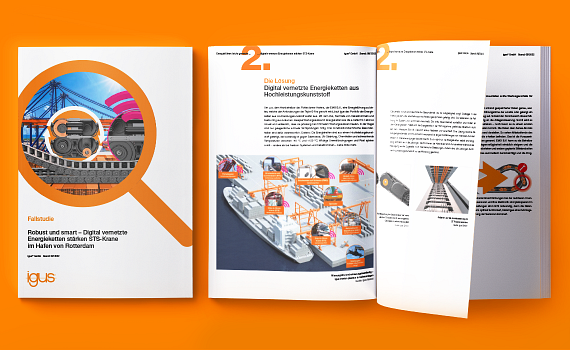Safe cable guidance on STS cranes at high wind speeds
Ship-to-shore-crane
This ship-to-shore crane can not only lift the container and set it down again, the whole crane girder can be moved vertically. This significantly shortens the lifting and lowering times. The previous energy chain solution with freely dangling cables was extremely prone to problems, because the cables could tangle all the time in strong wind, and then had to be untangled again by staff in a complex process taking up to 30 working hours. With igus® energy chains, however, the cables are safely routed.
Virginia International Terminals, Michael Petty,
Norfolk, Virginia, USA
Profile
- What was needed: Plastic energy chains
- Requirements: A safe cable guidance system was required that could safely move all cables, even at wind speeds of over 70km/h at the port.
- Industry: Crane technology
- Success for the customer: The cables in the old festooning system were snaking into each other and had to be untangled in a time-consuming and costly manner to ensure no connection damage. Using the e-chain, such work will be now be completely eliminated. After the first few months, the system proved to be the right choice.

Robust and smart – how digitally networked energy chains enhance STS cranes in the Port of Rotterdam
Download a free case study
This case study illustrates how EMO B.V. is able to achieve over 375,000km on its STS cranes with igus chains for cranes®.
Go to the PDF download
Problem
The special feature of this ship-to-shore crane is its jib (trolley girder), which makes it possible to drive very close to the containers to be loaded on ships, significantly reducing loading and unloading time. However, the system requires an enormous amount of power, communication, control and fibre optic cables. The problem in the application relates to the layout of the cable guidance, in which it is hung freely similarly to a festooning system. With winds in excess of 45 miles per hour, the cables became so tangled that it took between 20-30 man hours to rearrange the system. If the boom was raised or lowered without these precautions, it was assumed that the cables would be damaged and expensive repairs would result.Solution
In order to avoid time-consuming and cost-intensive maintenance work on the cables in the future, the operator decided on a new concept for cable guidance. The customer found the answer in a plastic energy chain from our company, more specifically a guidelok e-chain, where due to the large number of cables two such chains run in parallel. The free-hanging chains connect the boom for picking up the containers with the E-house of the crane and guide all cables safely and reliably. It was important to the operators that sufficient flexibility was also provided by the cable guidance to allow complete movement of the boom during lifting and lowering without restricting it.The redesign of the cable guidance was worthwhile and became apparent within the first few months after installation. Since then, the port has already experienced wind speeds of more than 70km/h on several days and not a single failure of the energy chain system or the cables attached has been detected.


